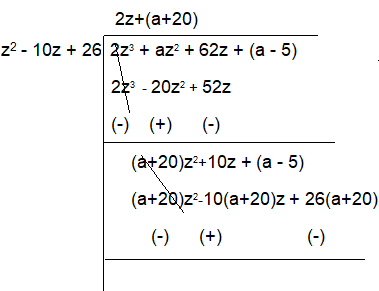HOW TO FIND THIRD DEGREE POLYNOMIAL FROM ZEROES
All cubic are continuous smooth curves. Every cubic polynomial can be categorized into one of four types.
Type 1 :
Three distinct real roots :
p(x) = a (x - p) (x - q) (x - r)
Type 2 :
Two real zeroes, one is repeated :
p(x) = a (x - p)2 (x - q)
Type 3 :
One real zero repeated three times.
p(x) = a (x - p)3
Type 4 :
One real and two imaginary zeroes.
p(x) = (x - p)(ax2 + bx + c)
Δ = b2 - 4ac
Problem 1 :
Find all third degree real polynomials with zeroes of -1/2 and 1-3i.
Solution :
Let the zeroes are p, q and r.
p = -1/2, q = 1 - 3i and r = 1 + 3i
From the complex roots, we can create a quadratic factor.
Sum of roots = 1 - 3i + 1 + 3i ==> 2
Product of roots = (1 - 3i)(1 + 3i)
= 12 - (3i)2
= 1 - 9(-1)
= 10
y = x2 - 2x + 10
Another zero is x = -1/2
Converting into factor, we get
y = (x + 1/2)
Multiplying linear and binomial factor, we get
y = a (2x + 1)(x2 - 2x + 10), where a ≠ 0
Problem 2 :
p(x) is a real cubic polynomial in which p(1) = p(2 + i) = 0 and p(0) = -20. Find p(x) in expanded form.
Solution :
p(1) = 0, p(2 + i) = 0
From this we understand two x-intercepts are 1 and 2 + i. Since one of the roots is a complex number, its conjugate can be considered as another root.
Roots are x = 1, x = 2 + i and x = 2 - i
From the complex roots, creating quadratic factor, we get
Sum of roots = 2 + i + 2 - i ==> 4
Product of roots = (2 + i)(2 - i)
= 4 - i2
= 4 + 1
= 5
Quadratic factor :
y = x2 - 4x + 5
Another zero is x = 1
Creating factor, we get
x - 1
Multiplying the factors, we get
y = a(x - 1)(x2 - 4x + 5), where a ≠ 0
From the above information, it is clear the curve is passing through the point (0, -20).
-20 = a(0 - 1)(02 - 4(0) + 5)
-20 = -5a
a = 4
Applying the value, we get
y = 4(x - 1)(x2 - 4x + 5)
Problem 3 :
5 - i is a zero of 2z3 + az2 + 62z + (a - 5), where a is real. Find a and other two zeroes are.
Solution :
Since the given zero is complex number, then another zero will be its conjugate.
Quadratic factor :
= z2 - (5 + i + 5 - i)z + (52 - i2)
= z2 - 10z + 26

Quotient = 2z + (a + 20)
10 + 10(a + 20) = 0
10 + 10a + 200 = 0
210 + 10a = 0
10a = -210
a = -210/10
a = -21
The value of a is -21.
Applying the value of a in quotient, we get
= 2z + (-21 + 20)
= 2z + 1
Equating each factor to zero, we get
2z + 1 = 0
z = -1/2
Problem 4 :
-2/3 and 2 are zeroes of 6x3 + ax2 - 4ax + b. Find the value of a and b.
Solution :
Zeroes are x = -2/3 and x = 2.
Let y = 6x3 + ax2 - 4ax + b
When x = -2/3, y = 0
0 = 6(2)3 + a(2)2 - 4a(2) + b
-48 = 4a -8a + b
-4a + b = -48 ----(2)
(1) + (2) x 7 ==>
28a + 9b - 28a + 7b = 16 - 336
16b = -320
b = -20
Applying the value of b in (2), we get
-4a - 20 = -48
-4a = -28
a = 7
Recent Articles
-
Finding Range of Values Inequality Problems
May 21, 24 08:51 PM
Finding Range of Values Inequality Problems -
Solving Two Step Inequality Word Problems
May 21, 24 08:51 AM
Solving Two Step Inequality Word Problems -
Exponential Function Context and Data Modeling
May 20, 24 10:45 PM
Exponential Function Context and Data Modeling